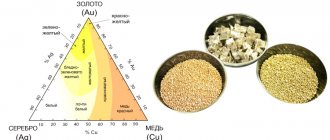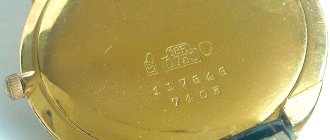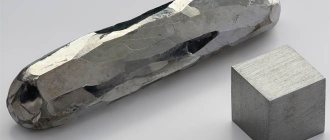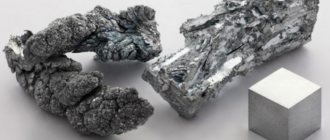Have you ever wondered why gold is more valuable than any other metal in the world? All kinds of jewelry and industries, glass production, aviation and space industries simply could not exist without it.
But why is gold so valuable in the world? To understand this, you need to know all its physical and chemical properties as a metal and, therefore, what determines its wide distribution in the world.
Gold and the ancient world
About 6,000 years ago, people began to meaningfully mine gold in Egypt. The oldest deposit of this precious metal, Nubia, hid about 6,000 tons. The first gold was mined by washing sands through cloth. Then they began to use more labor-intensive methods: separating the ore from the entire rock and grinding it.
Gold was used as a trade currency, a metal for making jewelry, dishes, weapons and armor for warriors. Since the ancient times of the emergence of mankind, this metal has been very common throughout the world.
Gold mining
Gold is characterized by its native form. In rocks, gold is usually dispersed at the atomic level. There are primary deposits of gold, placers into which it falls as a result of the destruction of ore deposits, and deposits with complex ores in which gold is extracted as an associated component.
On average, only 4 mg per ton of rock. This is one of the rarest elements. It is 3 times less than the rare metal palladium, 15 times less than silver, 300 times less than tungsten, 600 times less than uranium and 10 thousand times less than copper. At the same time, deposits and areas rich in precious metal are very numerous. Gold is contained in water: 1 liter of both sea and river water carries approximately 4 × 10−9 g of gold. This corresponds to 4 kilograms of gold in 1 cubic kilometer of water.
Gold and silver have been known to mankind for several millennia. This is evidenced by products found in ancient burials, as well as primitive mine workings that have survived to this day.
Science has proven that the blood of every person contains a small amount of gold, which, according to homeopathic doctors, is physiologically active.
The oldest gold was found in Neolithic burials of the fourth millennium BC. The main centers for the extraction of precious metals in ancient times were Egypt, Nubia, Spain, Colchis (Caucasus), and certain territories on the American continent and Asia. During excavations of the ancient city of Ur (Mesopotamia), skeletons with gold bracelets on their arms and legs were found. The burial dates back to 3500 BC. On the territory of Russia, gold began to be mined in 2-3 thousand BC. e.
The world's explored gold reserves are estimated at 100 thousand tons. Throughout history, humanity has mined about 140 thousand tons of gold. If you fuse all this gold together, you will get a cube with a side of approximately 19 m.
Chemical and physical properties
- Gold is a low-melting metal and therefore the most malleable. Melting point - 1064°C. Without heating, it can be forged into a layer about 0.1 microns thick. The most interesting thing is that in any form the metal retains its inherent properties. It will not be difficult for an experienced blacksmith to forge any, even the most elegant, figurine from this metal. Thanks to this plasticity, gold is used to cover temple domes and even create ultra-thin wires for microcircuits.
- From a physics point of view, metal is good because it has low resistance and, at the same time, good thermal conductivity; it is also resistant to all kinds of oxidative processes (corrosion, etc.). Why gold is valued in science is because it has the ability to reflect infrared rays and, in particular, light. This determines the use of gold in the glazing of aircraft and all kinds of aircraft models, astronaut helmets and sea vessels.
- Why is gold valued by jewelers? This metal lends itself well to all kinds of processing (soldering, polishing, etc.), and also easily forms alloys with any elements. These properties have become a powerful argument for taking the position of primacy of the main precious metal and raw material in the jewelry industry.
- As a chemical substance, gold is an inert metal, meaning it does not react with natural substances. The only exception is mirror amalgam (gold and mercury). As a result, its dissolution in acids, alkalis, and, in principle, under normal conditions is excluded. Unless in “aqua regia” (a solution that is a mixture of nitric and hydrochloric acids) of a concentrated form and under some other special conditions.
- Gold is a weak metal, which means another advantage is that it can be easily reduced to pure metal from any compound. For example, for amalgam, only 800°C is sufficient.
Uniqueness and consistency
People are still willing to steal, kill or die for gold, why? To begin with, this is a very beautiful, shiny and warm material. It's nice to look at and many people like to wear it. Gold has other advantages:
- The well-known truth says: what is valuable is what is rare. It could be quality, talent, animal or metal. In addition to the fact that this element is rare, it is also difficult to identify, mine and process. Therefore, high costs add value to it.
- Due to its endurance to unfavorable external factors, gold can be considered a leader. Not only research, but also the test of time has proven that this element is resistant to corrosion. This means air, water and sun will not damage or even change its appearance. For example, when archaeologists excavated the tomb of the Egyptian pharaoh Tutankhamun, his death mask shone like new, although several thousand years had passed since his death.
- Softness and ductility are what gold is valued for, especially by jewelers. It is easy to create a masterpiece from such material, and it will delight the eyes of connoisseurs for more than a century. To make the product stronger, harder components are added during manufacturing. Despite its softness, the metal has high density. For example, a cube of gold with a side of about 40 cm will weigh almost a ton.
- The element has high electrical conductivity, therefore it is successfully used in the manufacture of some electronic devices. Gold is almost unaffected by bacteria, which is why it is successfully used in dental prosthetics. If you roll such a metal to a very thin film, it will be transparent and will be able to transmit light, but not heat. This feature was useful for processing aircraft windows and vulnerable parts of spacecraft.
After taking a closer look, there should no longer be any doubt as to why gold is expensive. Wear jewelry with pleasure, admire the masterpieces of masters and use electronic devices.
Gold in medicine
All the properties described above clearly show the value of gold. Since ancient times, people have even associated healing properties with this metal. It was believed that it could cure any human ailment: relieve pain, cure allergies, improve memory, increase endurance and simply eliminate the effects of stress. Moreover, there was no need to carry out any special procedures; it was enough to just wear gold jewelry. Some healers believed that this metal could even prolong life.
Why is gold valued today? Followers of alternative medicine also believe that it will help those who have problems with the liver, heart, skin, reproductive system, as well as in the prevention of influenza and other seasonal diseases, because this precious metal kills viruses and pathogens.
Also in cosmetology, products containing a certain proportion of colloidal gold have advantages.
Deposits and their classification
The origin of our precious metal in deposits depends on the type of rock:
- Gold-quartz formations. Confined to fault zones. The metal distribution is uneven; enriched areas called “bonans” or “ore pillars” are formed.
- Deposits of gold-polysulfide-quartz formation. They are confined to granitoid and subvolcanic complexes. Average metal content is 10-15 g/t.
- Gold-larchite deposits. These include the Khaak-Sairskoye (Tuva), Mechnikovskoye, Kirovskoye (Ural) fields.
- Gold-sulfide deposits. Associated with volcanic-sedimentary strata.
- Porphyry gold deposits. This type includes the Bereznyakovskoye (Ural), Yubileinoye (Kazakhstan), Kyzyk-Chadr (Tuva) deposits.
- Deposits of oxidation zones. They are confined to the upper horizons of sulfide deposits in many sulfide deposits.
- Placer deposits often accompany primary gold fields. The length of placers is from 200-300 meters, less often 3-5 km. The width of the placers is 20-30 meters, less often - 100-300 meters. According to the conditions of occurrence, there are placers associated with river beds, floodplains, terraces, valleys, and intermountain depressions.
The world's largest gold deposit is located in South Africa. According to some reports, up to half of the world's production is obtained here.
Is there a lot of gold on Earth?
Many analysts believe that reserves of the mined “despicable metal” are difficult to calculate.
Experts give figures that vary by orders of magnitude (from 155,000 tons to 2.5 million tons).
There are countries where illegal gold mining is thriving, while other states prefer to keep production volumes secret. The principle “don’t count my money” works both for individual citizens and at the state level.
What determines the color of a gold item?
Jewelers call the substance in its pure form red gold. Because it is soft and susceptible to deformation, it is not used for smelting jewelry. But in order to improve the quality of the product, give it a special color and shine, pure gold is used in alloys. To obtain a yellow tint, it is mixed with silver and copper, red - with a large amount of copper, white - with palladium, platinum and nickel (this alloy is considered the most noble, but nickel is rarely used, as it can cause an allergic reaction). To add a white shine, a thin layer of rhodium can be applied to the jewelry to increase the strength of the product and its anti-corrosion properties.
What color of decoration should you choose?
Rose and yellow gold were considered low-grade and practically unsuitable for jewelry set with precious stones. But during the Soviet era, rose gold was very common; its popularity is explained by the fact that it looks beautiful and has a relatively low cost.
The most luxurious and expensive metal of the upper class of society is white gold. It has excellent quality characteristics and, due to the high content of silver and palladium, a fairly high price.
Speaking from a fashion perspective, both white and yellow gold are equally in trend now, since the design of the product plays a significant role, and not the color or weight of the metal.
The value of gold has developed historically
The statement that gold is a valuable asset is usually argued by financiers who prefer securities to precious metals. They have a mistakenly negative view of gold investing due to only taking the short term into account.
Let's analyze the price dynamics of the United States gold market from the beginning of the decline of the gold standard (1933) until its complete abolition (1971). All this time, the price of gold was steadily rising. A significant incentive for this was the permission of free trade in them.
To understand even better the value of the yellow metal and the stability of its purchasing power, let's look back centuries and millennia.
2000 years ago, during the supposed life of Jesus Christ, a Roman had the opportunity to purchase good-quality sandals, a leather belt and a toga for a gold ounce. Today, the same amount of gold has a value equivalent to a pair of expensive shoes, a formal suit and a leather belt.
Even earlier, in Babylon under King Nebuchadnezzar in the 4th century BC, a golden ounce was exchanged for 350 loaves. Now for 31.1 grams of yellow metal you can also buy at least 350 bread rolls.
If we consider how valuable an asset gold is in relation to real estate, then in the 70s of the last century, with the cost of an ounce of the precious metal being $193, a family home in the United States could be bought for 290 ounces. In 2014, with the cost of an ounce of the yellow metal already $1,266, the same house cost 225 gold ounces. And the remainder of 65 ounces could be spent on buying a car and installing a swimming pool.
It turns out that the value and purchasing power of the gold metal not only did not decrease, but also increased.
Today, paper national currencies have supplanted such a valuable asset as gold in the struggle for the right to be considered real money. Although the value of the banknotes is not backed up by anything other than promises of liquidity from the issuer. Even very recent history provides us with plenty of examples of how unreliable such promises can be. So should you blindly trust them?
The situation with securities is the same.
Government bonds and shares of companies from a century ago are now very likely to have lost their value. We are not saying that you cannot invest in them. It's just that different valuable assets have different purposes and must be viewed from a different time perspective.
The value of gold lies in its ability to save savings over a long period of time, as well as its ability to insure against risks associated with the economic crisis and inflation. It has been historically confirmed that these characteristics of the yellow metal have remained unchanged for thousands of years.
Gold classification (fineness concept)
The cost of the product does not depend on the color, but is determined by the fineness, that is, the amount of gold contained in the alloy.
Since jewelry is not made of pure gold, but of alloys with various metals, you need to ensure that jewelry does not interact with substances that contain iodine, mercury and chlorine.
The more craftsmen worked with this metal, the more varieties it appeared. How do you know which gold is more valuable?
For this purpose, all jewelry has a hallmark, for example, if it says 500 hallmark, it means that the product contains 50% pure gold. Accordingly, the higher the sample, the higher the cost.
A fair question arises: which standard of gold is valued higher? 999 is the highest mark of metal quality. But jewelers don't use it. It has found its application exclusively in coating all kinds of silver and other surfaces of products, protecting them from corrosion (tinsel). 585 and 750 samples are especially in demand among jewelers.
What makes gold such a valuable metal? Part one
Why is gold highly valued? For thousands of years, the yellow metal has functioned as a store of value, known to rise in value during times of economic and social unrest. Gold jewelry has been a popular luxury item since the dawn of the first civilizations.
Since then, the value of gold has only increased. In today's economy, gold's lack of correlation with stocks and many other assets makes it a financial safe haven during economic downturns or turmoil.
The value of gold is complemented by growing industrial and medical demand for it. The yellow metal's physical properties make it an essential element in many devices, from space probes and electronics to medical implants and cancer treatments.
1. Gold jewelry is valued for its beauty.
Gold has been prized for its beauty and rarity since prehistoric times. There is reason to believe that it was gold, and not copper, that was the first metal that our ancestors used to decorate objects. The fact is that this metal can be found in nature in almost pure form; It has a bright shine and is easy to process, so it is not for nothing that it is valued for its beauty.
With the development of large, centralized societies, gold proved popular not only for its decorative qualities, but also in a financial context. The yellow metal became one of humanity's first non-perishable forms of wealth and a long-term store of value.
The earliest known examples of gold jewelry were made from native gold 6,500 years ago, in the prehistoric civilization of Varna along the Black Sea. The vast amount of gold jewelry found in the graves of this civilization's great necropolis predates the first Sumerian and Egyptian gold jewelry by more than 1,500 years.
These finds show that gold was already a symbol of power and wealth in the Neolithic period. The importance of jewelry as a symbol of social status in the ancient world reached its zenith with the extravagant jewelry of the Egyptian pharaohs.
Currently, most of the gold mined in a year is used to create jewelry (according to the World Gold Council, about 49% of the metal mined was turned into jewelry in 2022).
In developing countries, where billions of people do not have access to a bank, buying gold jewelry is still considered the most popular method of preserving personal wealth. It is no coincidence that China and India, the countries with the largest rural populations, account for more than half of the world's demand for jewelry.
One of the disadvantages of using fashion jewelry as a store of value is that tastes change quickly. But this is not a concern for rural residents in developing countries, as they view large jewelry more as a store of value rather than as a fashion item. The design of gold jewelry has more significance in urban settings. As tastes in jewelry change, the markup due to the aesthetic characteristics of the jewelry over the cost of the metal and fineness largely disappears.
It is worth noting that the first serious alternative to gold jewelry as a store of value arose in western Turkey in the sixth century BC.
2. Gold coins were the first form of sound money
The next step in the evolution of gold as a store of value (and in the development of civilization as a whole) was the creation of the gold coin.
Gold's combination of high value and small size made it an excellent medium of exchange in antiquity, especially for long-distance trade. Despite this, gold was treated like any other barter item. Each ingot or nugget had its own weight and fineness, which had to be determined each time it was exchanged. There were the same problems with gold jewelry.
The famous king of Lydia, Croesus, minted the world's first pure gold coins around 550 BC.
Consequently, for the first time in history, gold coins of the same weight and fineness were created, which had a reputable issuer - the state. This practice quickly spread, strengthening trade between cities and kingdoms, and Lydia became the first trading empire.
Until the 20th century, monetary gold enabled unprecedented levels of business activity and international trade.
At the same time, gold and precious metal-backed currencies forced the authorities to exercise fiscal discipline. Until the early 20th century, people were suspicious of any paper currency that could not be exchanged for gold or silver.
1930s: US authorities seize gold for their own purposes
Only in the 1930s. gold ceased to function as money.
When the global Great Depression hit, people in many countries rushed to banks to exchange their paper bills for legal tender gold coins. The withdrawal of gold coins from banks took tens of millions of dollars out of circulation, reducing the money supply, leading to deflation. This worsened the effects of the Great Depression because the authorities could not print more paper money and back it up with gold.
Authorities around the world were forced to withdraw gold coins from circulation to prevent them from accumulating in citizens' safes and vaults. Governments then melted them down and added them to their national reserves. This forced the population to use paper money because gold coins could no longer be exchanged for banknotes.
Freed from the obligation to back paper currencies with gold, authorities can now print (and spend) as much money as they wish. As a result, budget expenditures lead to the devaluation of the currencies of all countries, and the price of gold rises (in those countries where it could still be purchased), which demonstrated its ability to be a means of insurance against the consequences of excessive budget financing.
In 1933, US authorities not only removed all gold coins from circulation, but also confiscated all the yellow metal held by the public. Since then, the US dollar has depreciated by about 95%. This means that $100 in 1933 is equal to $5 today.
Before government gold confiscation, you could exchange 100 paper dollars for 5 $20 Double Eagle gold coins, each containing 0.9675 troy ounces of the precious metal. That is, a total of 4.8375 ounces of gold was worth $100 in 1933 and is now worth $6,385 - a good illustration of how gold preserves wealth against inflation!
3. Gold plays the role of a hedging instrument against instability
One of the significant arguments supporting the value of gold is the fact that the world's central banks continue to buy and hold it as part of their official reserves. The pace of acquisitions of the yellow metal has accelerated recently as more central banks prepare for a new economic crisis. As you know, in 2018 the volume of gold purchases reached a 50-year high.
The role that gold plays on the balance sheet of the world's largest financial institutions is the same as for the individual investor:
— gold is a highly liquid asset. Each day, the yellow metal trades between $85 billion and $130 billion (on the spot market, in the form of options and futures). This makes it easy to buy and sell gold as needed and desired.
— gold is a defensive asset. Physical gold is the only asset that is not subject to default risk (counterparty risk). Gold protects wealth from inflation, government fiscal and monetary policies, and sudden geopolitical and economic shocks (such as war or stock market crashes). Physical gold is in some cases preferable for these purposes, since a large enough shock could prevent holders of gold futures, options or exchange-traded funds from getting the money they need if stock exchanges are closed during the crisis. At the same time, physical gold will be in high demand and can be easily sold at a premium.
— gold is financial insurance. The yellow metal has a traditional role as a diversification tool in investors' portfolios, reducing losses during times of financial instability. Note that, as with any form of insurance, buying gold can only protect your wealth if you purchase it in advance rather than waiting until a crisis occurs.
— gold is an effective tool for hedging an investment portfolio due to its negative correlation with most assets. For example, during periods of economic growth, stock prices and the value of the dollar rise. Gold prices also rise during this period, but not as much as stock prices. Increased demand for gold is observed during economic growth from jewelry and electronics manufacturers.
But during an economic downturn, when stocks and currencies (and sometimes even bonds) fall in value, gold rises faster in all currencies, reducing losses from stocks and fixed income assets, providing a relatively high total return for an investment portfolio.
Gold performs well during periods of economic growth, but at the same time reduces losses during periods of recession.
Another form of investment use of gold is to hedge currency risks, especially between the dollar and the currencies of developing countries. Excessive volatility in emerging market currencies and the cost of purchasing traditional currency hedging instruments may reduce returns. Gold functions as a currency hedge for multiple currencies simultaneously, reducing the need to hedge for each individual currency pair.
4. The special properties of gold make it useful for industrial applications
Non-investment forms of using gold were tested at the beginning of human history. Gilded domes on buildings in the ancient world protected the roof from the elements, while ceilings decorated with gold leaf protected the soot of fireplaces.
Gold also works well with glass. In ancient Rome, gold salts were used to create a red tint to glass, that is, ruby glass. An incredibly thin layer of gold, less than a micron thick, is used in modern windows to protect against solar heat.
In terms of energy production, gold nanoparticles have significantly improved the efficiency of photovoltaic cells used in solar cells and have also improved hydrogen fuel cells. This application has enormous potential for creating clean energy that is independent of solar and wind, as well as improving power generation for manned space probes.
Gold is also used in heavy industry. Gold plating on moving parts in harsh environments, such as inside jet engines, allows them to perform longer and better. In all of the examples above, the yellow metal either improves the manufacturing process or protects its essential components.
5. Gold is a vital raw material for various technologies
The yellow metal has been increasingly used for technology since the advent of the integrated circuit and the information age. Although copper and silver are more efficient conductors of electricity than gold, their effectiveness decreases as the connections tarnish and rust.
Gold connectors, however, will not tarnish or rust. This makes gold a more suitable material for lining electrical connectors and in integrated circuits. Gold's ability to protect metals from tarnishing in electronics is especially valuable for aerospace applications.
6. Aeronautics cannot exist without gold
Gold has played an important role in aeronautics since the beginning of the space age. Gold-plated protective surfaces reflect heat and radiation, protecting the spacecraft and satellites from solar radiation. These precautions are necessary because space does not have an atmosphere to remove heat from the surface. Gold foil primarily protects materials in space from heat.
Even NASA's Mars rovers need gold protection to regulate the temperature of sensitive instruments and batteries in low temperature conditions.
The gold coating reflects harmful infrared radiation while still allowing the astronaut to see through their visors. The reflective gold coating on the visor also protects the suit from overheating inside.
Engineers developing early satellites and spacecraft needed lubricants for moving parts that could withstand the harsh cold, heat and radiation of space. Traditional lubricants break down almost immediately in this environment. Gold's flexibility and resistance to cold welding have made it a useful material for coating moving parts where they touch.
7. Using gold in the medical field saves people
The use of gold in medicine has increased significantly in recent years, although at one time it was used only for fillings and dentures. Gold's ability to treat arthritis was first discovered in 1929. The yellow metal's antimicrobial properties make it a useful element for coating implants, especially in infection-prone areas such as internal echoes.
Gold can be alloyed with titanium, used in prosthetics, to reduce the likelihood that the body will reject the prosthesis. The new high-temperature gold-titanium alloy is four times harder than titanium and is biocompatible thanks to the yellow metal.
Comparison of 585 and 750
In Russia, these samples are most common, because they have an affordable price-quality ratio, which is why they are popular among a large number of the population of the post-Soviet space.
If we talk about 585 sample, it should be noted that it is very practical for daily use, even if you work in production.
But many are inclined to believe that since 750 gold has a higher gold content, it is definitely better. This is wrong. The more pure gold there is in a product, the softer it is, not as wear-resistant, and it can be accidentally damaged. Typically, it is more appropriate to purchase products of such a high standard for celebrations or other special occasions in your life.
Application of noble metal
Today, the old royal gold (banknotes in the form of coins) has long been out of use. An alloy is used, and it is often rhodium-plated, as a result the product may turn black. Gold-plated jewelry also darkens. The price of the blackened product is low.
However, the cheapest jewelry is with minimal gold content.
Today, various products are made from precious metal alloys: gold watches, jewelry, electronics parts, and reflective coatings. Scrap gold is melted down, while the products still remain the most expensive (if the best ratio of alloys was used during production). Many stores offer products online; you can select them by photo.
Gold chain around the neck
How to buy a quality product
When the question is already closed: “Why is gold valued?”, we can talk about what you should pay attention to when buying products made from this noble metal.
First, find out the sample of the product and compare it with the sample on the tag. The jewelry must have a special stamp from the manufacturer - a kind of guarantor of quality and authenticity. Also, don’t forget to check the tag. It contains all the necessary information about the product, manufacturer, composition, weight, and so on.
Pay attention to the appearance of the product. Make sure that all fastenings and soldering points are of good quality. Also, there are no unevenness or pronounced defects in the jewelry.
How gold is mined
North-Eastern Siberia, Kuranakh ore field.
Photo: PJSC Polyus Gold mining is carried out in the following countries: South Africa, Australia, USA, Canada, Russia, China and Pakistan. One of the largest gold mines is the Aurora mine, located in Guyana, Africa.
In ancient times, pieces of gold were simply found in a river or earth. During the Gold Rush, gold was mined by hand using a pick and shovel. By 1853, hydraulic mining had emerged and replaced independent gold miners. Today, gold is mined in large open-pit or underground mines.
The process begins with geologists taking samples of the ore to determine the best places to mine. Once mining engineers know where the gold is and what other materials surround it, the mining process can begin.
Advertising - Continued below
If gold is located close to the surface, it is mined by open-pit mining. In fact, a huge hole is dug in the ground, along the inner perimeter of which a road goes down like a spiral. Equipment for mining and moving ore goes down and up along this road.











